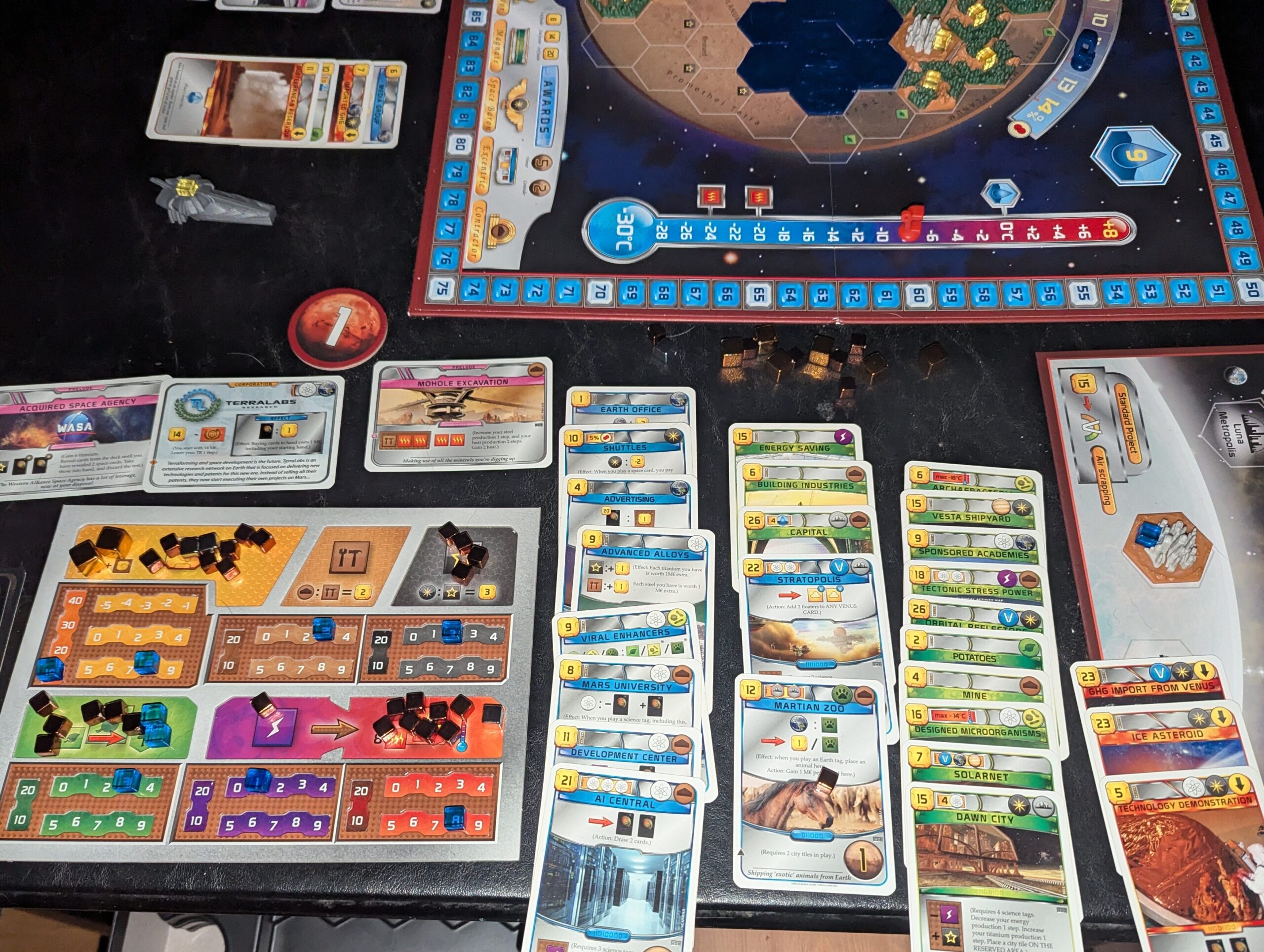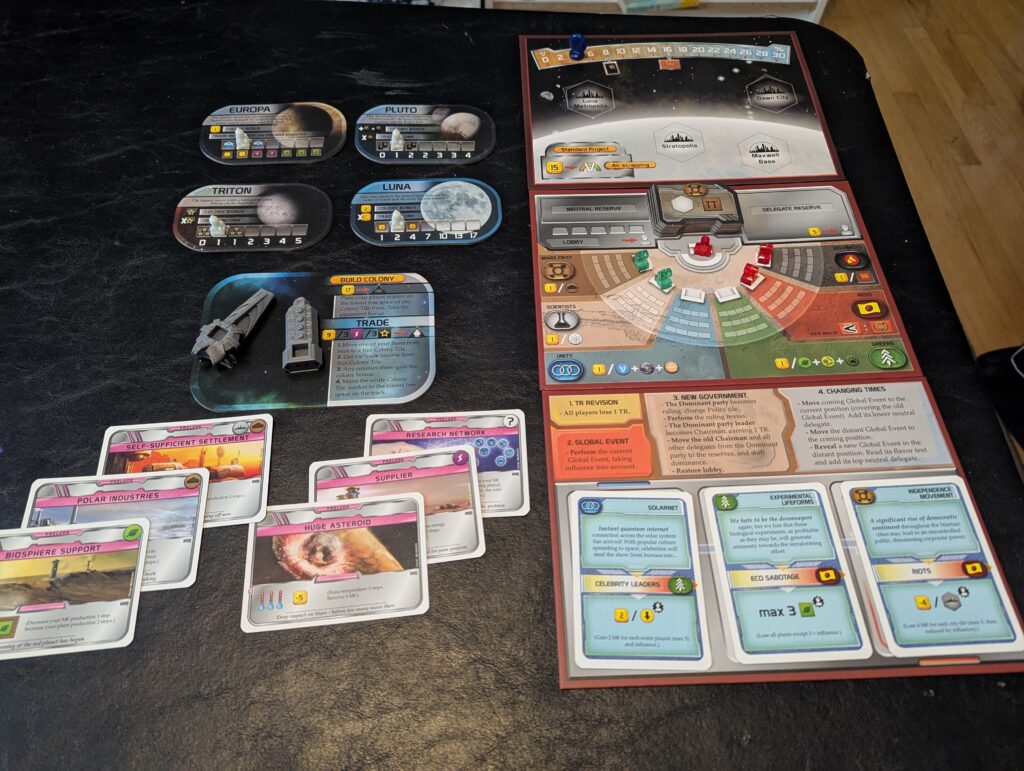
If you’ve spent more than 5 minutes talking with me about board games, there’s a non-zero chance I’ve talked about Terraforming Mars from FryxGames. Released in 2016 with numerous expansions doled out like clockwork, my friend Jack got me hooked on this game and I’ve subsequently gone all in on it, purchasing almost every expansion and various Etsy game enhancements to feed more yearning desire to make Mars wetter, hotter, and greener.
The base game largely revolves around a map of hexes that represent various geologic features and potential resources on and off the red planet. Every round roughly represents a human generation as players acting as corporations compete for government funding to make Mars livable. Various trackers on the board mark just how progress has been made and when Mars can’t get any more hot, wet, and green, the game is over and everyone counts up their score.
The simplest way to terraform Mars is to throw money at the planet but this makes a slow and tedious process even moreso which is why the game gives you the opportunity to research and implement projects in the form of a massive stack of cards that boost your economy, add alternative scoring options, or throw sand in your rivals’ engines.

Most of the cards boost your player board which both acts as storage for the resources you’ll produce and collect as well as your production reminder so you can see just how much income, metals, biomass, energy, and heat you’ll produce at the end of every round.
Sidenote: this particular set of player boards was purchased from etsy and may be the most game enhancing purchase I made. Because you have to keep your various production levels very clear, the two layered slotted board keeps the cubes from sliding about when the table gets bumped or you sneeze.
Some cards will give you bonus actions, others will create triggering effects, and yet more will let you crash asteroids into your friends or unleash ants into their labs to eat their precious microbes. One particular bit of weirdness this game has is making you pay twice for most of your cards. At the start of the game and then every round you’ll draw a hand of cards and then pay for which ones you want to keep. Then on your turn you have the option to pay the printed card cost to put them into play. This creates tension between trying to prioritize your resources with wanting to fill your hands with exciting projects and sets Terraforming Mars apart from most games.
Another sidenote: the game has rules for drafting cards every round and passing them back and forth between players but I have never enjoyed playing that way and routinely skip that.
Along with dotting Mars with forests and oceans, you also can erect cities which grants some economic boosts but largely is a way to score points at the end of the game as well as claim real estate to block your rivals. Because forests can only be planted next to other tiles, cities let you seed the perchlorate-heavy soil for future growth and development. The board also has unlockable milestones and awards which players can race to unlock for a heavy dollop of points.
As generations pass, Mars will get busier and more filled up and so the game becomes partially a race to terraform faster and better and gobble up the limited planetary resources but because there are so many pathways to victory you can have games where Mars is a lush garden by the end or still a dusty smog-choked hellscape dotted with factories and mines. Some players may be fully invested in planting cities and trees and others may realize controlling the orbit and space lanes with asteroid colonies, space stations, and questionable security forces is worth more victory points at the end of the game. There are lots of fiddly cards and strategies but you can choose to interact with or ignore any of all of them and both are viable strategies.

This flexibility is part of what makes the expansions work as well as they do. The four shown here clockwise from the upper right are Venus Next, Turmoil, Prelude, and Colonies. Venus and Colonies introduce whole new worlds with a bunch of cards, new terraforming goals, and a trade mechanic but you can discard every V card you run across and never set foot on Venus or Pluto and be no worse off. Prelude gives your starting game an initial economic boost so it goes a little faster and gives you a starting direction to explore and of all of these is the one I recommend the most. Turmoil adds about an hour to the game as you do Politics and while I find it a charming mess, don’t recommend it unless you have a very idiosyncratic group. There are also new maps you can play on and my most ridiculous purchase – the 3d pieces. I love both but leave their necessity to your conscience and budget.
(The more recent expansions (Prelude 2 and Automa incorporate a lot more generative AI art and content and as such I opted not to get them.)
So why do I love Terraforming Mars so much? A lot of it has to do with the way the setting and theme click with the gameplay and mechanics. There is something so stirring about starting a game off with a blank, barren canvass and watching it come to life over the course of a few hours. The cards also create a fantastic and organic narrative and their juxtaposition can be hilarious, heartbreaking, or both. In one game, I set up refugee camps only to immediately deploy conscript labor to build a commercial center. In another game, a friend built a meat industry suspiciously soon after starting Mars’ only zoo. The expansions only supercharge this process, giving your imagination ample opportunity to picture colonists on Ganymede watching the skies for hungry trade convoys or Martian separatists storming the administrative domes.
This is a brick of a game with an intimidating teach and a lot of seeming complexity but as you play it starts to zoom along and I have found few games as rewarding and rich for inherent storytelling. But you don’t have to take my word for it. My 7 year old asked if we could play it instead of watch TV which is about the highest praise I can think of.
